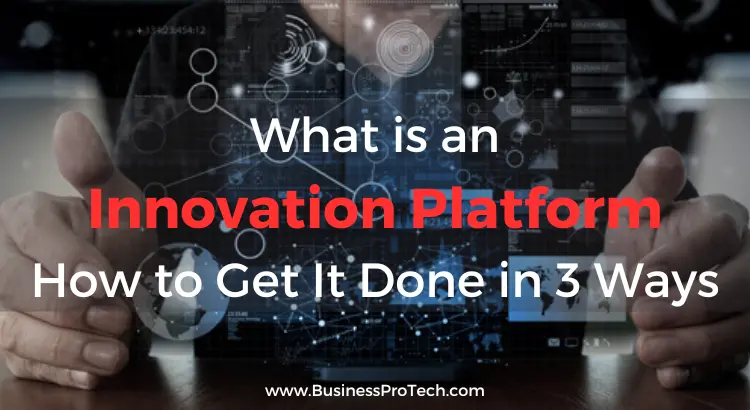In today’s rapidly evolving business landscape, innovation has become a crucial driver of success. Companies are constantly seeking ways to foster creativity, collaboration, and problem-solving to stay ahead of the competition.
This is where innovation platforms come into play. An innovation platform is a structured approach that enables organizations to harness the collective intelligence of their employees, customers, and partners to generate groundbreaking ideas and drive transformative change.
In this article, we will explore what an innovation platform is and provide three effective ways to implement it successfully.

Defining an Innovation Platform
An innovation platform is a technology-enabled framework that facilitates idea generation, collaboration, and the execution of innovative initiatives. It serves as a centralized hub where individuals from various departments, teams, and even external stakeholders can contribute their insights, expertise, and ideas.
This platform provides a structured process for capturing, evaluating, and implementing ideas, ultimately driving innovation within the organization. It leverages digital tools, such as collaboration software, ideation platforms, and project management systems, to streamline the innovation journey.
Implementing an Innovation Platform
Establishing a Culture of Innovation:
Before implementing an innovation platform, organizations must cultivate a culture that values and encourages innovation. This involves fostering an open and inclusive environment where employees feel empowered to contribute their ideas and experiment with new approaches.
Leadership should communicate the importance of innovation, provide resources, and recognize and reward innovative efforts. Creating cross-functional teams and encouraging collaboration can also enhance the innovation culture.
Choosing the Right Technology:
Selecting the appropriate technology is crucial for an effective innovation platform. There are numerous software solutions available that offer features such as idea generation, collaboration, workflow management, and analytics.
Organizations should assess their specific needs and choose a platform that aligns with their goals and objectives. User-friendly interfaces, scalability, integration capabilities, and security measures are factors to consider while evaluating potential platforms.
Structuring the Innovation Process:
Implementing a structured innovation process ensures that ideas are captured, evaluated, and executed efficiently. The process typically consists of stages such as idea generation, screening, evaluation, development, and implementation.
The innovation platform should provide clear guidelines and workflows for each stage, enabling seamless progression and transparency. Regular checkpoints and milestones help track progress and ensure alignment with strategic objectives.
Maximizing Engagement and Collaboration

Encouraging Participation:
To drive engagement, organizations need to actively encourage employees, customers, and partners to participate in the innovation platform. This can be achieved through internal marketing campaigns, awareness programs, and training sessions to familiarize users with the platform’s features and benefits. Incentives, such as rewards or recognition, can also motivate individuals to contribute their ideas.
Facilitating Collaboration:
Collaboration is a key element of successful innovation. The platform should enable users to connect, collaborate, and build upon each other’s ideas. Features like discussion forums, commenting, and voting systems facilitate meaningful interactions and allow for the refinement of ideas.
Moreover, fostering a sense of community and creating virtual spaces for collaboration can further enhance the innovation ecosystem.
Providing Feedback and Recognition:
Timely feedback is crucial to sustaining engagement and motivation. The innovation platform should allow for feedback loops, enabling users to receive comments and suggestions on their ideas. Recognizing and celebrating successful innovations, whether through public acknowledgment or rewards, reinforces a culture of innovation and encourages continued participation.
An innovation business platform is a comprehensive technological solution that facilitates and supports various aspects of the innovation process within an organization. It serves as a centralized hub where employees can access valuable resources, collaborate on projects, share knowledge, and contribute their ideas to drive innovation and achieve the best possible results.
At its core, an innovative business platform provides a structured framework and set of tools that enable employees to navigate the innovation journey effectively. It offers guidance on how and where to focus their efforts, streamlining processes and fostering a culture of innovation within the company.
The Main Features of an Innovative Business Platform Typically Include:
Idea Management:
The platform provides a systematic approach for capturing, evaluating, and managing ideas generated by employees. It enables individuals to submit their ideas, facilitates collaboration and feedback, and ensures proper evaluation and selection of the most promising concepts.
Knowledge Sharing:
An innovation business platform serves as a repository of knowledge, allowing employees to access and share relevant information, best practices, research findings, and lessons learned. It promotes cross-functional collaboration, eliminates silos, and enables employees to leverage existing knowledge to spark new ideas.
Collaboration and Communication:
The platform offers various communication and collaboration tools to facilitate teamwork and enhance productivity. It enables employees to connect, discuss, and collaborate on projects, fostering a collaborative environment that encourages creativity and innovation.
Project Management:
An innovation business platform often includes project management features to streamline the execution of innovative initiatives. It provides tools for setting goals, creating timelines, assigning tasks, tracking progress, and ensuring accountability throughout the project lifecycle.
Analytics and Performance Tracking:
To measure the effectiveness of innovation efforts, the platform incorporates analytics capabilities. It tracks key performance indicators, provides insights into the innovation pipeline, and enables data-driven decision-making to optimize resource allocation and prioritize initiatives.
Today, in the ever-evolving business landscape, companies across all industries require a technical instrument that guides their employees toward optimal outcomes. This crucial tool is often referred to as an innovative business platform. But what exactly does this term mean?
Basically, we can define an innovation platform as a digital tool that combines within its function a problem-solving set of options, a workflow facilitator, and an innovation detector. Therefore, we are talking about something more complex than a mere workflow organizer, though this function maintains a central position within the several features of such a tool. If we take a panoramic look at the most innovative and fulfilling innovation platforms among the ones currently available on the international market (like, for example, the one provided by Dassault Systèmes), we can easily notice that the first characteristic that immediately jumps to the eye is their extreme flexibility. This means being able to carry out different tasks, at the same time and (most important) in real-time, allowing the employees to save time and energy, as well as focus on their specific skills, without wasting their mental stamina doing something they’re not properly trained for.
If we try to take a deeper look at the main function of such platforms, we can summarize them in the following macro-areas.
- It puts at a company’s disposal a virtual environment where each employee can interact with his/her colleagues and co-workers, even those who are located in a different physical location (for instance those who are working remotely). Each department has its own space, but they’re all networked and easy to be reached.
- It processes independently data and work protocols, in order to provide every human resource involved in the production process easy access to them as well as a key to interpret the results obtained by such process.
- It is able to simulate the results of a project, the way it would work, and any possible criticality, in order to prevent failures and reconfigure the project in a more profitable way.
- Finally, it analyses in detail market data, sales figures, and statistics, so that anyone involved in the company’s production and sales process can easily detect issues, weak points, and flaws. It is also able to suggest possible solutions, over both the short and long term.
Conclusion
In other words, an innovation platform helps a company (and those who run it) keep up with its competitors. It enhances strategies and working routines. And last but not least, it optimizes the inner resources, starting from the human ones.